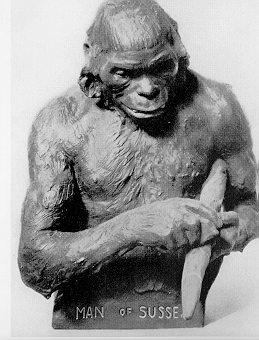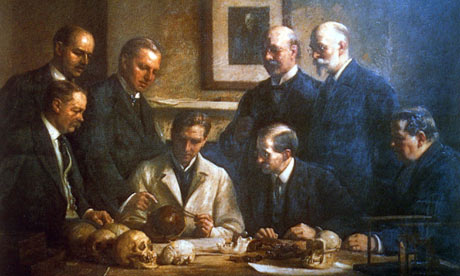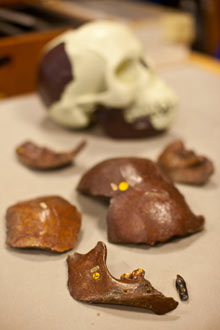
Piltdown Man, “Discovered” in 1912.
February 5, 2012

Piltdown Man, “Discovered” in 1912.

Bodies of evidence: John Cooke’s 1915 painting of the Piltdown men – see large image for details. Photograph: Nils Jorgensen/Rex Features
The Guardian has an interesting read today. In “Piltdown Man: British archaeology’s greatest hoax,” we learn that…
In a few weeks, a group of British researchers will enter the labyrinthine store of London’s Natural History Museum and remove several dark-coloured pieces of primate skull and jawbone from a small metal cabinet. After a brief inspection, the team will wrap the items in protective foam and transport them to a number of laboratories across England. There the bones and teeth, which have rested in the museum for most of the last century, will be put through a sequence of highly sensitive tests using infra-red scanners, lasers and powerful spectroscopes to reveal each relic’s precise chemical make-up.
The aim of the study, which will take weeks to complete, is simple. It has been set up to solve a mystery that has baffled researchers for 100 years: the identities of the perpetrators of the world’s greatest scientific fraud, the Piltdown Hoax.
For more, read here.

Bones of contention: the ‘skull’ fragments with a full-size replica. Photograph: Antonio Olmos
The Piltdown hoax has many levels of mystery, however, and another question that needs to be answered is: What are the species of origin for the Piltdown skull?
As the article notes, the Piltdown hoax was revealed when “a team led by geologist Kenneth Oakley, anatomist Wilfrid Le Gros Clark and anthropologist Joseph Weiner took a closer look and in 1953 announced that Piltdown’s big braincase belonged to a modern human being while the jawbone came from an orangutan or chimpanzee.”
So what can be learned about the “human” skull and what species of “orangutan or chimpanzee” constituted the rest of the hoax? You can’t tell me that no one is curious.
As is often mentioned in cryptozoology and hominology, anthropologists are especially careful about the evidence for Bigfoot because they were fooled so badly by the Piltdown hoax. Standards of “proof” increased after the Piltdown affair, we are told. Perhaps if the detective work done on the 100 year old hoax solves some of the enigmas of this hoax, Science can move on from the post-traumatic distrust that appears to have resulted from that 100 year old event?

A replica of the Piltdown Skull can be viewed at the International Cryptozoology Museum.
Support the museum’s educational mission with your donation. Simply click on the following button to give $5, $10, $50, $100, whatever you can send…
Start 2012 on a positive note. Give to a good cryptozoology cause.
Much appreciation.
About Loren Coleman
Loren Coleman is one of the world’s leading cryptozoologists, some say “the” leading living cryptozoologist. Certainly, he is acknowledged as the current living American researcher and writer who has most popularized cryptozoology in the late 20th and early 21st centuries.
Starting his fieldwork and investigations in 1960, after traveling and trekking extensively in pursuit of cryptozoological mysteries, Coleman began writing to share his experiences in 1969. An honorary member of Ivan T. Sanderson’s Society for the Investigation of the Unexplained in the 1970s, Coleman has been bestowed with similar honorary memberships of the North Idaho College Cryptozoology Club in 1983, and in subsequent years, that of the British Columbia Scientific Cryptozoology Club, CryptoSafari International, and other international organizations. He was also a Life Member and Benefactor of the International Society of Cryptozoology (now-defunct).
Loren Coleman’s daily blog, as a member of the Cryptomundo Team, served as an ongoing avenue of communication for the ever-growing body of cryptozoo news from 2005 through 2013. He returned as an infrequent contributor beginning Halloween week of 2015.
Coleman is the founder in 2003, and current director of the International Cryptozoology Museum in Portland, Maine.
Filed under CryptoZoo News, Forensic Science, Fossil Finds, Hoaxes